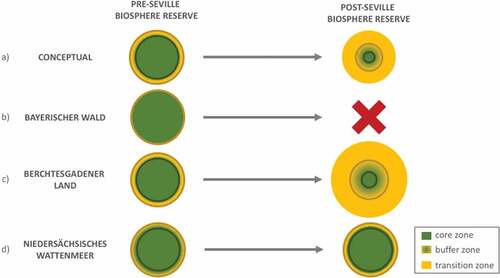Figures & data
Figure 1. Changes in the focus of Biosphere Reserves before and after 1995. (a) Conceptual shift from nature protection with a dominant core zone to sustainable development with a dominant transition zone. (b) Bayerischer Wald with a focus on the core zone is no longer a BR. (c) Berchtesgadener Land which had a marginal transition zone before 1995 which got extended. (d) Niedersächsisches Wattenmeer which major part was and is the core zone with a marginal buffer zone and no considerable transition zone.

Figure 2. Map of Germany with the three areas: (a) Bayerischer Wald: National Park since 1970 and BR between 1981–2007; (b) Berchtesgadener Land: National Park since 1978 and BR since 1990; (c) Niedersächsisches Wattenmeer: National Park since 1986, biosphere reserve since 1992, and World Heritage Site since 2009.

